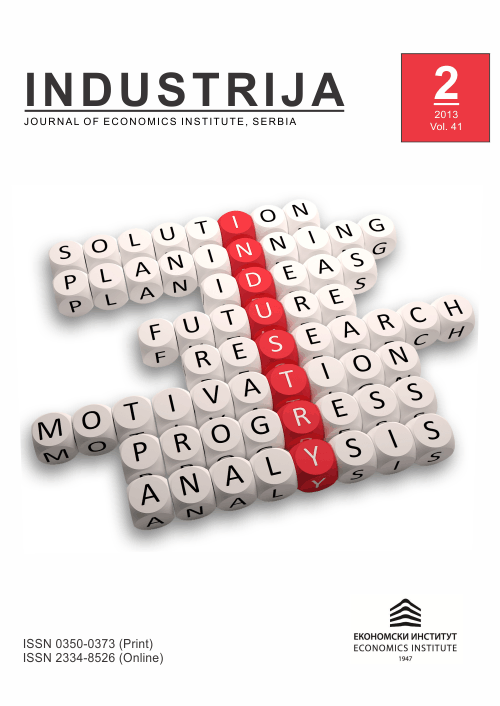Efikasnost monetarne i fiskalne politike u Srbiji
Sažetak
The effectiveness of fiscal and monetary policy has been the center of debate between Keynesians and the monetarists for a long time. However, the results from numerous empirical studies are inconclusive, suggesting that none of the policies can be thought of as superior to the other and their relative effectiveness in any economy depends on the prevailing economic and political conditions at any point in time. In order to determine the influence of fiscal and monetary policy on the economic activity in Serbia, we employed unit root and cointegration tests, as well as the regression analysis on the series of quarterly data for the period 2003-2012. The obtained results show that monetary policy is more effective in stimulating economic growth comparing to fiscal policy. Hence, the overall conclusion is that government should pay more attention to the fiscal policy to improve its efficiency in the future.
Reference
--
Ajayi, S.I. (1974). An Econometric Case Study of the Relative Importance of Monetary and Fiscal Policy in Nigeria. The Bangladesh Economic Review, 2(2), 559-576. Retrieved from http://www.jstor.org/stable/40795755.
Ajisafe, R.A., & Folorunso, B.A. (2002). The Relative Effectiveness of Fiscal and Monetary Policy in Macroeconomic Management in Nigeria. The African Economic and Business Review, 3(1), 23-40. Retrieved from www.theaebr.com/v3n1Ajisafe.pdf
Ali, S., Irum, S., & Ali, A. (2008). Whether Fiscal Stance or Monetary Policy is Effective for Economic Growth in Case of South Asian Countries. The Pakistan Development Review, 47(4), 791-799. Retrieved from www.pide.org.pk/pdf/PDR/2008/Volume4/791-799.pdf
Batten, D.S., & Hafer, R.W. (1983). The Relative Impact of Monetary and Fiscal Actions on Economic Activity: A Cross-Country Comparison. Federal Reserve Bank of St Louis Review, 65(1), 5-12. Retrieved from http://research.stlouisfed.org/publications/review/83/01/Relative_Jan1983.pdf
Brooks, C. (2002). Introductory Econometrics for Finance. Cambridge: Cambridge University Press.
Campillo, M., & Miron, J. (1997). Why Does Inflation Differ Across Countries. In C.D. Romer & D. Romer (Eds.), Reducing Inflation: Motivation and Strategy. (pp. 335-362). Chicago: The University of Chicago Press.
Chowdhury, A.R. (1986). Monetary and Fiscal Impacts on Economic Activities in Bangladesh: A Note. The Bangladesh Development Studies, 14(2), 101-106. Retrieved from http://www.jstor.org/stable/40795239.
Chukuigwe, E.C., & Abili, I.D. (2008). An Econometric Analysis of the Impact of Monetary and Fiscal Policies on Non-Oil Exports in Nigeria: 1974-2003. African Economic and Business Review, 6(2), 59-73. Retrieved from www.theaebr.com/Vol6No2Fall2008Chukuigwe.pdf.
Elliot, J.W. (1975). The Influence of Monetary and Fiscal Actions on Total Spending: The St. Louis Total Spending Equation Revisited. Journal of Money Credit and Banking, 7(2), 181-192. Retrieved from http://www.jstor.org/stable/1991348.
Enache, C. (2009). Fiscal Policy and Economic Growth in Romania. Annales Universitatis Apulensis Series Oeconomica, 11(1), 502-512. Retrieved from http://oeconomica.uab.ro/upload/lucrari/1120091/50.pdf
Revised Memorandum on Budget and Economic and Fiscal Policy for 2011 with Forecasts for 2012 and 2013. Belgrade: Government of the Republic of Serbia.
Gujarati, D.N. (2003). Basic econometrics. Boston: McGraw-Hill.
Jawaid, S.T., Arif, I., & Naeemullah, S.M. (2010). Comparative Analysis of Monetary and Fiscal Policy: A Case Study of Pakistan. NICE Research Journal, 3, 58-67.
Kvrgić, G., Čolić, Z., & Vujović, T. (2011). Značaj koordinacije mera monetarne i fiskalne politike. Bankarstvo, 40(3-4), 32-61.
Lane, R.P. (2002). Monetary - Fiscal Interactions in an Uncertain World: Lessons for European Policymakers. Institute for International Integration Studies. Trinity College Dublin and CEPR. Retrieved from. Retrieved from http://www.tcd.ie/Economics/TEP/2002_papers/TEPNo13PL22.pdf.
M'amanja, D., & Morrissey, O. (2005). Fiscal Policy and Economic Growth in Kenya. Centre for Research in Economic Development and International Trade. University of Nottingham. Research Pape. Retrieved from http://www.nottingham.ac.uk/credit/documents/papers/05-06.pdf
-Ministry of Finance. (2012). Bulletin Public Finance January 2012. Belgrade: Ministry of Finance.
National Bank of Serbia. Retrieved from www.nbs.rs
-National Bank of Serbia. (2012). Monetary Policy Programme of the National Bank of Serbia in 2013. RS Official Gazette,
Ogbole, O.F., Amadi, S.N., & Essi, I.D. (2011). Fiscal Policy: Its Impact on Economic Growth in Nigeria 1970 to 2006. Journal of Economics and International Finance, 3(6), 407-417. Retrieved from http://www.academicjournals.org/jeif/pdf/pdf%202011/June/Ogbole%20%20et%20al.pdf.
Okoro, A.S. (2013). Impact of Monetary Policy on Nigerian Economic Growth. Prime Journal of Social Science, 2(2), 195-199. Retrieved from http://www.primejournal.org/PJSS/pdf/2013/feb/Okoro.pdf
Olaloye, A.O., & Ikhide, S.I. (1995). Economic Sustainability and the Role of Fiscal and Monetary Policies in a Depressed Economy: The Case Study of Nigeria. Sustainable Development, 3, 89-100.
Rakic, B., Pesic, M., & Radjenovic, T. (2012). The Effects of Fiscal Policy in the Contemporary Economic Crisis Conditions. FACTA UNIVERSITATIS Series: Economics and Organization, 9(4), 393-405. Retrieved from http://facta.junis.ni.ac.rs/eao/eao201204/eao201204-01.pdf
Senbet, D. (2011). The Relative Impact of Fiscal versus Monetary Actions on Output: A Vector Autoregressive (VAR) Approach. Business and Economic Journal, 25, 1-11. Retrieved from http://astonjournals.com/manuscripts/Vol2011/BEJ-25_Vol2011.pdf.
Statistical Office of the Republic of Serbia. Retrieved from www.stat.gov.rs
Šestović, L. (2008). Fiskalna politika u Srbiji u prvim godinama tranzicije i predstojeći izazovi. In Tekuća privredna kretanja, ekonomska politika i strukturne promene u Srbiji 2007/2008. (pp. 91-109). Retrieved from http://bs.scribd.com/doc/28314753/Fiskalna-Politika-u-Srbiji.
Waranya, A. (2007). International Differences in the Relative Monetary-Fiscal Influence on Economic Stabilization. Journal of International Economic Studies, 21, 69-84. Retrieved from http://repo.lib.hosei.ac.jp/bitstream/10114/226/1/21atchariyachanvanich.pdf.
--

